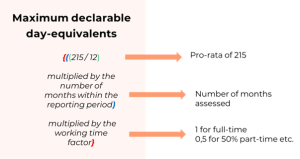
Maximum declarable Day-equivalents in Horizon Europe
If you have a Horizon Europe grant, avoiding errors in declaring personnel costs should be a high priority.
To calculate personnel costs, you need to understand two basic concepts: ‘Day-equivalents’ and ’Daily rate’.
Let’s focus first on the concept of maximum declarable day-equivalents, which is the maximum number of days that can be declared per person.
Horizon Europe uses a fixed number of 215 eligible days of work per year. It means that you cannot charge more than 215 days per person working full-time in a single year. If the person works part-time, you need to adjust the maximum day-equivalents to a pro-rata following the formula: 215 * working time factor as shown below. You may also deduct the number of days the person has spent on parental leave.

Figure 1: Formula to calculate the maximum declarable day-equivalents
If the working time factor changes for a certain employee, the maximum declarable day-equivalents must be calculated separately. For example, if a person worked full-time for 9 months and 50% part-time for the other 3 months, we calculate the maximum declarable day-equivalents separately for each period. Then we sum up the two figures for reporting.
Once the number of the maximum declarable day-equivalents is determined, you can now calculate personnel costs, starting with the daily rate of a person working on the project. The formula for calculating the daily rate is to divide the actual salary during the months within the reporting period by the maximum declarable day equivalents. The calculated daily rate is then multiplied by the number of days worked on the Horizon Europe project.
To learn more on how to calculate Daily rate in Horizon Europe, see our post The Complicated World of Daily Rates in Horizon Europe.
What is needed to prove days worked on the project?
Two options are available for this:
- Time records (timesheets) signed monthly or,
- Monthly declarations on days spent for the action.
A common question that arises is: what should we do if our time-recording system is in hours? Well, you need to convert the total hours worked into day-equivalents. To make this conversion, and so to calculate the number of day-equivalents, you need to divide the number of hours worked by the person during the reporting period by the number of hours of a day-equivalent.
For more details about the time recording system in Horizon Europe check our blog post Time recording system in Horizon Europe.
If you need help with your personnel cost calculation, we will be happy to assist you! Contact us at: hello@getpolite.eu